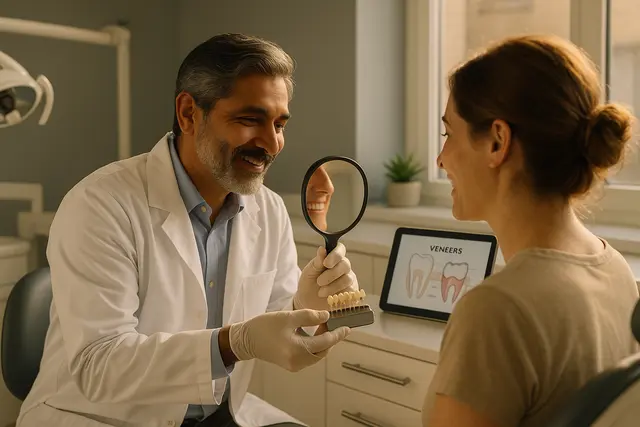Cosmetic Dentistry
6 min read
Mar 20, 2025
Dental Veneers: Types, Costs, and Long-Term Care
Dental veneers have revolutionized cosmetic dentistry, offering solutions for discoloration, chips, gaps, and misalignment. This guide examines veneer types, costs, procedural details, and maintenance strategies to help patients make informed decisions.

Most of us have stood in front of a mirror, smiled, and then zoomed in on something we didn’t love. Maybe it’s a chip, a funky color, or a tooth that’s just... not vibing with the rest. That’s where veneers come in. They’re one of those cosmetic fixes that sounds fancy, but at their core? They’re just here to help your teeth look good and feel good.
If you’ve ever wondered what veneers are actually like, how much they cost, what they’re made of, or if they’re even worth it, this is your guide. No jargon. No fluff. Just real answers from someone who gets that you want to improve your smile without losing your mind (or your entire paycheck) in the process.
So, What Are Veneers Anyway?
Think of veneers as tiny jackets for your teeth. Not full-on winter coats, just sleek, custom-made covers that go on the front surface of your teeth to make them look straighter, whiter, or just a whole lot nicer.
They’re made from either porcelain or composite resin, and they’re super thin, like, paper thin, but still strong enough to handle your morning coffee and the occasional accidental popcorn kernel. A dental veneer can be a lifesaver if your teeth are chipped, uneven, stained, or just not doing their job in the selfie department.
Your dentist will usually shave a little bit of enamel off (don’t worry, it’s not as scary as it sounds) and then use dental cement to bond the veneer in place. Once it’s on, it’s on. Veneers are considered permanent, which is why this isn’t a “just for fun” type of dental treatment. It’s more like a committed relationship. With your teeth.
The Different Types of Veneers (Because Yes, There’s More Than One)
Not all veneers are created equal, and you’ve got a few options depending on your needs, your budget, and how much time you want to spend in the dentist’s chair.
Porcelain veneers are the classics. They look natural, they last long, and they resist stains like champs. If you're after a smile that looks like it belongs on a red carpet, this is probably your best bet.
Composite veneers (aka composite resin veneers) are the more affordable cousin. They can often be applied in one visit, and while they don’t last quite as long as porcelain, they still do a pretty solid job at improving the appearance of your smile.
No-prep veneers are the low-commitment option. Your dentist doesn’t need to grind much (or any) enamel, so they’re less invasive, but also a bit bulkier than traditional ones.
Temporary veneers are used while you wait for the real deal to be made at the dental lab. They're like a loaner car for your mouth.
And then there are snap-on or pop-on veneers, which sound cooler than they usually are. These are removable, more cosmetic than corrective, and best for short-term wear like photo shoots or special events. Not ideal if you’re trying to eat corn on the cob.
Each type of veneer may offer something different, and a good dentist will walk you through what fits your situation best. Maybe you only need to fix one front tooth. Maybe you’re going for the full smile makeover. Either way, the right choice comes down to your lifestyle, your goals, and yes, your wallet.
Let’s Talk About Veneer Costs (Because We Know You’re Wondering)
Here’s the part that makes people sweat a little: the price. Veneers aren’t cheap, but the cost of your veneers depends on a bunch of things, what type you get, how many you need, and where you live.
On average, porcelain veneers run from $900 to $2,500 per tooth. Composite veneers tend to be cheaper, usually between $250 and $1,500. Yep, per tooth.
Now, are veneers covered by insurance? Usually not. Veneers are cosmetic, and dental insurance doesn’t like to pay for anything that’s “just” for looks. But if your veneer is fixing a damaged or broken tooth, there’s a slight chance your plan might chip in. It’s always worth asking.
Keep in mind: you’re not just paying for the material. You’re paying for time, skill, and the dental technician who custom designs each veneer like a tiny piece of artwork. High-quality dental work isn’t fast food, it’s more like fine dining for your mouth.
What Happens to Your Actual Teeth?
Let’s clear this up: veneers don’t ruin your teeth. But they do require a little sacrifice.
To get veneers placed, your dentist will usually file down a small layer of enamel on the surface of your teeth. This makes room for the veneer to sit flush without looking bulky. Once that enamel is gone, it doesn’t grow back. That’s why veneers are permanent and why you really have to be sure before getting them.
That said, veneers don’t damage the core of your tooth. They sit on the front like a super-thin shield, and when bonded correctly, they actually help protect the surface of a tooth. Your natural teeth are still there underneath, just upgraded.
Veneers vs. Crowns: What’s the Difference?
People get these mixed up all the time, so here’s the quick cheat sheet:
A veneer covers the front surface of a tooth (just the part you see).
A crown wraps around the whole tooth like a protective helmet.
If your tooth is healthy but needs a glow-up, go veneer. If your tooth is cracked, has a big filling, or is structurally weak, a crown might be the safer bet.
How Long Do Veneers Last?
If you take care of them, veneers can last a long time, porcelain veneers typically last 10–15 years, while composite veneers last closer to 5–7 years. Veneers don’t last forever, but they’re definitely not short-term either.
Here’s the deal: brush your teeth, floss, don’t chew ice or use your teeth to open things (you know who you are), and visit your dentist regularly. Veneers are tough, but not indestructible.
Are Veneers Right for You?
Veneers aren’t for everyone. If you grind your teeth at night, don’t take care of your enamel, or have gum disease, your dentist may suggest something else first. But if your teeth are healthy and you’re just looking to boost your confidence or cover something that’s always bugged you, veneers could be exactly what you need.
Veneers can improve your smile. They can help you feel more confident walking into a job interview, posing for photos, or just laughing without covering your mouth. That’s not just cosmetic, it’s life-enhancing.
Final Thoughts
Veneers are one of the most popular dental services for a reason. They’re beautiful, they’re functional, and when done right, they can totally transform the way you feel about your teeth. But like anything that lasts a decade, they take commitment. You’ll want a skilled cosmetic dentist, a good dental lab, and a game plan for long-term care.
So if you’ve been weighing the pros and cons of veneers, now you’ve got the info. Whether you’re fixing one chipped tooth or dreaming of a full smile makeover, remember this: the goal isn’t perfection. It’s feeling like yourself, with a little extra sparkle.
What Exactly Are Veneers and What Do They Fix?
Veneers are thin, custom-made shells, usually made from porcelain or composite resin, that bond to the front of your teeth to improve their appearance. They're commonly used to fix chipped, stained, uneven, or slightly misaligned teeth. Veneers can make your smile look straighter and brighter without major dental work.
How Much Do Veneers Cost and Are They Covered by Insurance?
Veneers can range from $900 to $2,500 per tooth for porcelain, and $250 to $1,500 for composite. They're considered cosmetic, so most dental insurance plans don’t cover them unless there’s a medical reason. Costs also depend on your location, dentist, and how many teeth you’re treating.
Do Veneers Damage Your Natural Teeth?
Veneers don’t ruin your natural teeth, but they do require removing a thin layer of enamel so the shell fits properly. This enamel doesn't grow back, which makes veneers a permanent decision. However, when done correctly, they protect the tooth's surface and enhance its appearance without harming the tooth’s core.
How Long Do Veneers Last and How Should You Care for Them?
Porcelain veneers typically last 10–15 years, while composite veneers last about 5–7 years. To make them last, brush and floss daily, avoid chewing hard objects like ice, and see your dentist regularly. Good habits keep your veneers looking great and protect your natural teeth underneath.
Read Next
Related Posts

Cosmetic Dentistry
Looking for a Dentist Who Whitens Teeth? Here’s What to Know First
A brighter smile can do wonders for your confidence, but finding the right dentist who whitens teeth takes more than just a quick Google search. From treatment options to experience and safety measures, there are a few key things you should know before booking that whitening appointment.
3 min read
Sep 10, 2025

Cosmetic Dentistry
What Type of Dentist Does Veneers? Here’s Who to Trust With Your Teeth
Dreaming of a flawless, photo-ready smile? Veneers can be a game-changer, but only if you choose the right expert to apply them. Understanding who’s qualified to handle this cosmetic procedure is key to getting results that look natural and last for years.
5 min read
Sep 08, 2025

Cosmetic Dentistry
Cosmetic Dentistry and Implants: How They Work Together
A confident smile can do wonders for your self-esteem, and modern dentistry offers more ways than ever to achieve it. Whether you're dealing with missing teeth or simply want a brighter, more balanced look, cosmetic dentistry and dental implants provide powerful solutions that work hand-in-hand to restore both function and aesthetics.
5 min read
Sep 05, 2025
Don’t have time to research every dentist around you?
See why 30k+ patients trusted us